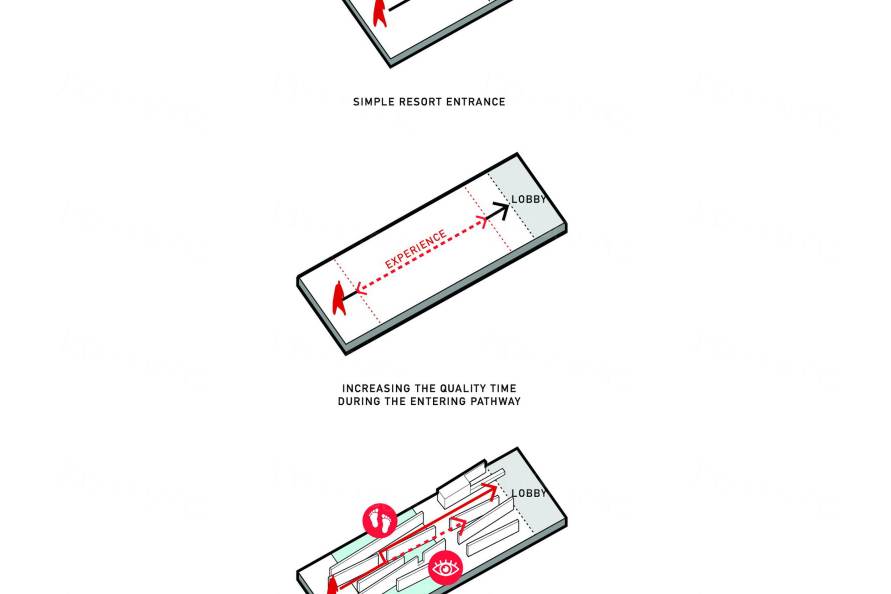这座小型度假酒店位于桂河岸边,是一座举办婚礼、会议和研讨会等其他热闹活动的场所。这些设施为整个周期的活动计划和未来在场地后部客房的扩建留出空间。与场地面积相比,客房数量相对较少。因此,设计师决定更多地关注每个功能区域之间的空间,并引用了“旅程比目的地更重要”的想法,作为项目的初衷。
Situated at the Kwai riverbank, a small
resort is a lively event host for weddings, conferences, and seminars. The
facilities serve a full cycle of event programs and the future expansion of
guestrooms on the back of the site. Comparing to the site area, the number of
guestrooms is quite small. So, the designer decided to pay more attention to
the space between each functional area and used an idea from the quote that
the journey is more important than the destination, as source material.



▽设计推演

这一理念通过人们的感官来体现:用手触摸材料的质地、用视觉分辨光影,用听觉感受呼啸的风声,用嗅觉闻到雨后土壤的味道。所有这些都成为用户体验中不可或缺的一部分,特别是当他们从度假村的一个区域过渡到另一个区域时。
The concept is represented through the human
senses, i.e., touching the texture of material, seeing the light and shadow
in the view, hearing the whistling wind, and smelling the soil after
rainfall. All of them become an integral part of users' experience, in
particular, while they walk from one place to another in the resort.
▽入口经过“感官”的体验

建筑布局将主要流通与每个公共区域连接起来,同时尽可能多地保留现有树木。通过最大限度地利用狭窄的场地,大楼内的多功能厅和所有主要区域都可以看到河流的景色,包括泳池和位于河岸边的庭院区域。
The building layout connects the main
circulation with every common area while keeping the existing trees as many
as possible. By taking advantage of the narrow site, the function room in the
building and all the main areas have access to the river view - including a
swimming pool and a courtyard located alongside the riverbank.


设计师在连接游泳池和庭院空间的另一侧设置了一片独立区域,用于家庭套房。如此一来,家庭区可能产生的噪音干扰便不会打扰到其他客人。度假村也设有为二人世界提供的蜜月套房类型。其宽敞的区域让情侣远离住在度假村另一侧的其他游客,得以享受隐私。
On the other side of the continuous space
connecting the swimming pool and the courtyard lay an exclusive family suite
in the separated area. So, the possible noise disturbance from the family
zone cannot reach the other guests easily. However, the resort can
accommodate a spouse as a honeymoon suite type. Thanks to its spacious area,
the resort planning lets the couple enjoy their privacy by keeping them from
other visitors who stay in another wing of the resort.
|

▽客房室内




|

|
▽餐厅

别墅是度假村的中心。客人们通过半户外的过渡空间进入室内居住空间。所有的推拉门都可以完全打开,以便在微风习习的天气里,室内外空间可以融合在一起,并且使得室内区域和朝向室外泳池的露台都可以作为活动场所。
The villas are the heart of the resort. While
entering it, the guests walk through the semi-outdoor space, which functions
as a transition space before reaching the indoor living area. When all of the
sliding doors fully open on a pleasant breezy day, the indoor and the outdoor
space merge and become one space. They can support any activity, whether it
happens either in the indoor area or on the terrace towards the swimming pool
outside.



业主的基本要求是将土地的地面保持在街道水平以下三米的右侧,或大约是单层建筑的高度。因此,多功能球场和游泳池可以与河流更紧密地相连。该决策促使设计师为大量的土壤的转移找到了解决方案,即利用土壤,这边是夯土墙的来由,它成为度假村的主要特色。在度假村的入口处,夯土墙的位置起着双重作用-作为用户生活体验的序幕和尾声。有时,它们会创造可访问性的选择,引导访问者沿着路径花费时间。它们还支持专注于功能空间之间空间排列的核心思想。夯土墙成为与用户和人类感官互动的媒介,展现设计师的初心。
The owner's essential requirement was to keep
the ground level of the land on the right-wing three meters below the street
level or approximately the height of a single-story building. So, the
multi-purpose court and the swimming pool can be more closely connected to
the river. The decision also led the designer to find a solution for the
large quantity of soil removal, and then he came up with adopting the idea of
utilizing it. That is the starting point of the rammed earth wall, which
becomes the main feature of the resort. At the entrance of the resort, the
rammed walls' position plays a double role - as a prologue and an epilogue to
a living experience of the users. Sometimes, they create accessibility
choices that allow visitors to spend time along the pathway. They also
support the core idea that focuses on the arrangement of space between
functional spaces. The rammed earth walls become a medium that interacts with
the users and the human senses, as the designer's initial intention.
▽入口的夯土墙




Tara别墅的设计师重视功能之间的空间,而不是物质层面的体量。正如老子所言:“埏埴以为器,当其无,有器之用”。项目的设计过程将概念转化为有形的建筑。同时也是有效利用材料的一个例子。将剩余的土壤重新用作特征元素——夯土墙,这一创意为度假村创造了独特的个性。特殊的夯土墙呈现出具有实感的体量,甚至强化了设计理念,引导游客沿着路径消磨时间,体会设计的核心思想,即“旅程比目的地更重要。” |
Tara
Villa is the project that designer values on the spaces among functions rather
than the physical structure. It refers to what Lao Tzu (Lao Zi) said: "We
shape clay into a pot, but it is the emptiness inside that holds whatever we
want." The design process of the project utterly transforms the concept
into a tangible architecture. It attempts to realize an example of the
efficient utilization of the material.
The idea of reusing the leftover soil to be the feature element - rammed
earth walls - generates a unique character for the resort. The particular
rammed earth walls bring about a physical outcome. It even strengthens the
design concept and engages the users to spend time along a pathway. So, they
can enjoy and experience the elements that incorporate the idea of the
abovementioned quote: "the journey is more important than the destination."
▽夜景




▽总平面图

▽分层平面图

|

|

|

|
▽剖面图
PROJECT
TITLE:Tara Villa
LOCATION:Kanchanaburi, Thailand
ADDRESS:Mueang, Kanchanaburi, 71150,
Thailand
START
- COMPLETE DATE:2014 - 20/ 12/ 2019
OPENNING
YEAR:N/A
USABLE
AREA (SQM):5,900
OWNER:Pramot Kamolpantip
ARCHITECT:IDIN Architects (Jeravej
Hongsakul, Eakgaluk Sirijariyawat, Wichan Kongnok)
INTERIOR
DESIGNER:IDIN Architects (Jureerat Korvanichakul)
STRUCTURAL
ENGINEER:Pakanut Siriprasopsothorn
CONTRACTOR:ArtCon
PHOTOGRAPHER:DOF Sky|Ground

|